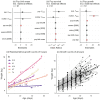Little evidence of inbreeding depression for birth mass, survival and growth in Antarctic fur seal pups
- PMID: 38824161
- PMCID: PMC11144264
- DOI: 10.1038/s41598-024-62290-x
Little evidence of inbreeding depression for birth mass, survival and growth in Antarctic fur seal pups
Abstract
Inbreeding depression, the loss of offspring fitness due to consanguineous mating, is generally detrimental for individual performance and population viability. We investigated inbreeding effects in a declining population of Antarctic fur seals (Arctocephalus gazella) at Bird Island, South Georgia. Here, localised warming has reduced the availability of the seal's staple diet, Antarctic krill, leading to a temporal increase in the strength of selection against inbred offspring, which are increasingly failing to recruit into the adult breeding population. However, it remains unclear whether selection operates before or after nutritional independence at weaning. We therefore used microsatellite data from 885 pups and their mothers, and SNP array data from 98 mother-offspring pairs, to quantify the effects of individual and maternal inbreeding on three important neonatal fitness traits: birth mass, survival and growth. We did not find any clear or consistent effects of offspring or maternal inbreeding on any of these traits. This suggests that selection filters inbred individuals out of the population as juveniles during the time window between weaning and recruitment. Our study brings into focus a poorly understood life-history stage and emphasises the importance of understanding the ecology and threats facing juvenile pinnipeds.
© 2024. The Author(s).
Conflict of interest statement
The authors declare no competing interests.
Figures



Similar articles
-
Ménage à trois on Macquarie Island: hybridization among three species of fur seal (Arctocephalus spp.) following historical population extinction.Mol Ecol. 2006 Oct;15(12):3681-92. doi: 10.1111/j.1365-294X.2006.03041.x. Mol Ecol. 2006. PMID: 17032266
-
Low reproductive success in territorial male Antarctic fur seals (Arctocephalus gazella) suggests the existence of alternative mating strategies.Mol Ecol. 2001 Feb;10(2):451-60. doi: 10.1046/j.1365-294x.2001.01186.x. Mol Ecol. 2001. PMID: 11298959
-
Kin selection may influence fostering behaviour in Antarctic fur seals (Arctocephalus gazella).Proc Biol Sci. 2003 Oct 7;270(1528):2033-7. doi: 10.1098/rspb.2003.2467. Proc Biol Sci. 2003. PMID: 14561291 Free PMC article.
-
An 85K SNP Array Uncovers Inbreeding and Cryptic Relatedness in an Antarctic Fur Seal Breeding Colony.G3 (Bethesda). 2020 Aug 5;10(8):2787-2799. doi: 10.1534/g3.120.401268. G3 (Bethesda). 2020. PMID: 32540866 Free PMC article.
-
Untangling unexpected terrestrial conservation challenges arising from the historical human exploitation of marine mammals in the Atlantic sector of the Southern Ocean.Ambio. 2023 Feb;52(2):357-375. doi: 10.1007/s13280-022-01782-4. Epub 2022 Sep 1. Ambio. 2023. PMID: 36048407 Free PMC article. Review.
Cited by
-
Inbreeding reduces fitness in spatially structured populations of a threatened rattlesnake.Proc Natl Acad Sci U S A. 2025 Aug 26;122(34):e2501745122. doi: 10.1073/pnas.2501745122. Epub 2025 Aug 18. Proc Natl Acad Sci U S A. 2025. PMID: 40825128 Free PMC article.
-
Sustainability in the laboratory: evaluating the reusability of microtitre plates for PCR and fragment detection.R Soc Open Sci. 2025 May 21;12(5):242226. doi: 10.1098/rsos.242226. eCollection 2025 May. R Soc Open Sci. 2025. PMID: 40400527 Free PMC article.
References
-
- Charlesworth D, Charlesworth B. Inbreeding depression and its evolutionary consequences. Annu. Rev. Ecol. Syst. 1987;18:237–268. doi: 10.1146/annurev.es.18.110187.001321. - DOI
MeSH terms
Grants and funding
LinkOut - more resources
Full Text Sources

